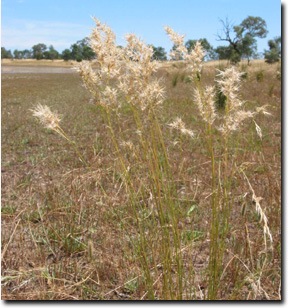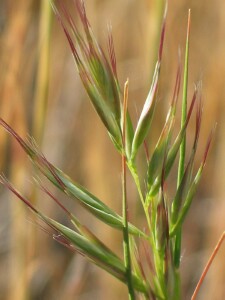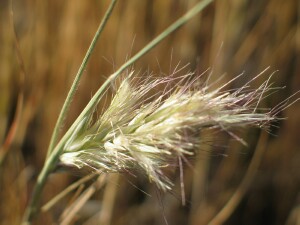Bristly Wallaby-grass
Back | Salinity Indicator Plants Home | Common name home | Scientific name home | Photo Gallery | Glossary
| Bristly Wallay-grass Photos | Family: Grass (Poaceae syn. Gramineae) |
| Scientific Name: | Rytidosperma caespitosum (syn. Austrodanthonia setacea) |  Bristly Wallaby-grass Photo: A J Brown | |||||
|
| ||||||
Status: | Native to Victoria, Western Australia, South Australia, New South Wales and Tasmania. | ||||||
| Perennial tussock grass to 70 cm, with fine, linear leaves which are usually in-rolled and covered with scattered hairs (particularly towards the base of the blades). Ligule a ciliate rim (0.5 mm long) with a few longer hairs at the sides. The pale greenish to purplish flower-head is rather contracted and 3 – 8 cm long with 10 or more spikelets made up of 4 – 10 florets. The individual florets have two lateral rows of long hairs on the back and a hairy base. The body of the floret is usually 2 – 3.5 mm long, ending in two 6 – 12 mm long acuminate lobes with a bent and twisted, rather fine awn arising from the notch between the lobes. Flowers mainly in spring. | ||||||
| Found growing in a wide range of soils on slopes and flats. Often occurs in unimproved pastures, found on moderately saline soils, and sometimes associated with scalds.
| ||||||
Comments: | There are many species of Wallaby-grass but only a few grow in wet environments and most are not salt tolerant. Bristly Wallaby-grass is a very variable species with some forms approaching Common Wallaby-grass. Bristly Wallaby-grass usually has smaller florets than Common Wallaby-grass but the bristles (long acuminate points) on its floret lobes are longer (4 – 6 mm long). |
 Bristly Wallaby-grass - young flowerhead Photo: A J Brown |  Bristly Wallaby-grass - mature flowerhead Photo: A J Brown |
|



